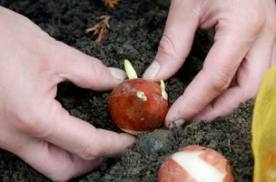
Order your spring-blooming bulbs now to have the best selection. The bulb growers will ship your bulbs in time for proper planting in our area. Local nurseries also stock bulbs to coincide with the best planting time for our area.
Select the largest bulbs available; mature bulbs produce more flowers. Choose heavy, dense bulbs with no decay or mold. Pre-packaged bulbs frequently cost less, but they are likely to produce smaller blooms.
Plant your bulbs in the fall when temperatures remain consistently cool and the soil temperature has cooled to below 60 degrees. If you plant too early, when the soil is still warm, you are likely to end up with lots of top growth and fewer flowers.
If your bulbs arrive before you are ready to plant, open the packages to give the bulbs good air circulation. Store them in a cool, dark, dry place.
Despite what your grandmother may have told you, it is not necessary to pre-chill bulbs in our area. Tests done by Sunset Magazine and the U.C. Master Gardeners showed that there was little difference in the performance of pre-chilled and non-chilled bulbs.
Choose a location for spring-flowering bulbs that receives at least five to six hours of sunlight. You can even plant under deciduous trees as the trees generally do not leaf out until after the bulbs have bloomed.
It is critical to plant bulbs where the soil drains well. Bulbs hate to have “wet feet” and will let you know by rotting instead of blooming.
Plant all bulbs with the pointy end up and the root scars down. Follow directions on planting depth for that type of bulb. The general rule is to plant most types of bulbs three times as deep as the bulb is wide.
Bulbs need water while they are actively growing. Even though you cannot see them after planting, remember to irrigate until winter rains begin.
Soil preparation depends on whether you are planting for repeat bloom. Bulbs contain all of the nutrients they need for the coming season’s growth and bloom. But if you want bulbs to repeat in successive seasons, amend your soil with compost and other nutrients. Do not put fertilizer in the planting hole as bulbs are susceptible to root burn. Instead, dig bulb fertilizer into the soil under the root zone or broadcast fertilizer over the beds after planting.
For repeat blooming, leave the bulbs in the soil after flowering and allow the leaves to turn brown so that the bulbs build back their reserves for the following season. Daffodils, native iris, muscari and scilla are the most reliable repeat bloomers in our area.
I have a love affair with tulips but have finally admitted that they do not repeat well in my garden. I also have very active gopher and rodent populations, and they consider tulip bulbs a culinary delight.
My solution is to treat my tulips as annuals. I grow them in strategically placed two-foot diameter pots that I also use for summer annuals. When the annuals are giving up the ghost in fall, I remove them from the pots and plant tulips in the same soil. There is no need to enrich the soil at this point as the bulbs contain all of the nourishment they need for a single season. When the tulips have finished their spectacular demonstration, I remove the bulbs, renew the soil in the pots, add compost and fertilizer and plant flowering annuals. This way, I have an almost continuous display of blooms in the same pots with minimal effort.
Because the critters do not seem to like daffodils, I have had success in naturalizing daffodils for repeat bloom in several locations in my garden. Daffodils do not require the cooler winter temperatures that tulips demand so are much better suited for repeat blooming in the Napa Valley.
Whether you choose to naturalize daffodils in your yard, grow tulips as annuals in pots or experiment with varieties of bulbs you have never tried, now is the time to plan your spring bulb garden. A small amount of effort this fall should provide you with a magical floral display next spring.
Workshop: Napa County Master Gardeners will present a workshop on “Planting Spring Bulbs” on Saturday, September 14, from 9:30 a.m. to 11:30 a.m., at University of California Cooperative Extension, 1710 Soscol Avenue, Napa. Plant bulbs now for a colorful display in early spring and find hidden beauty in your garden. Learn about different kinds of bulbs, how to plant them and what they need to thrive. Online registration (credit card only) Mail in registration (cash or check only).
Garden Tour: Napa County Master Gardeners will host a self-guided garden tour, “Down the Garden Path,” on Sunday, September 22, from 10 a.m. to 4 p.m. Visit seven unique gardens in and around downtown Napa, all maintained by Master Gardeners. Tickets: $25 advance/$30 day of event. For more information and to purchase tickets, visit http://ucanr.edu/ucmgnapa or call 707-253-4147. Find us on Facebook under UC Master Gardeners of Napa County.
Master Gardeners are volunteers who help the University of California reach the gardening public with home gardening information. Napa County Master Gardeners ( http://ucanr.org/ucmgnapa/) are available to answer gardening questions in person or by phone, Monday, Wednesday and Friday, 9 a.m. to Noon, at the U. C. Cooperative Extension office, 1710 Soscol Avenue, Suite 4, Napa, 707-253-4143, or from outside City of Napa toll-free at 877-279-3065. Or e-mail your garden questions by following the guidelines on our web site. Click on Napa, then on Have Garden Questions?